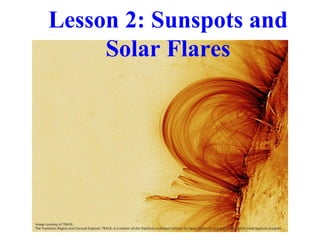
L2SolarFlares.pptx
- 1. Lesson 2: Sunspots and Solar Flares
- 2. What is the Sun? The Sun is a Star, but seen close-up. The Stars are other Suns but very far away.
- 3. The Sun is giant ball of very hot, mostly ionized gas that shines under its own power. What is the Sun? Radius 696,000 km (109 times Earth’s radius) Rotation Rate 27 days (equator) to 31 days (poles) Luminosity (Power Output) 3.8 x 1026 watts (10 trillion times the power consumption of all Earth’s nations combined) Surface Temperature 5,800 K (average) Mass 2 x 1030 kg (300,000 times Earth’s mass) Composition (by percentage of mass) 70% Hydrogen, 28% Helium, 2% heavier elements Core Temperature 15 million K Age 5 billion years (expected to live another 5 billion) Solar Data
- 4. • The Sun is 109 times the diameter of Earth (10 times the diameter of Jupiter). • Over 1,000,000 Earths could fit inside the Sun. • The Sun is 150 million kilometers away from Earth. 390 times farther away than the Moon. • You would need to line up 11,700 Earths side by side to cover the distance between Earth and Sun. • It takes light 8 minutes to travel to Earth from the Sun. Size and Distance of the Sun Sun Earth Moon
- 5. Core • Nuclear Fusion H → He • T = 15,000,000 K Radiative Zone • Energy transported by light • T = 10,000,000 K Convective Zone • Energy transported by convection Photosphere • Visible surface • Far less dense than Earth’s atmosphere • T = 5,800 K • Sunspots: T = 4,000 K Chromosphere • Thin layer above photosphere • Produces most of Sun’s UV light • T = 10,000 K Corona • Tenuous, extends out millions of kilometers • Emits X-rays • T = 1,000,000 K The Different Parts of the Sun
- 6. Sunspots Sunspots are dark splotches on the face of the Sun. They are typically about 2,000 degrees Kelvin cooler than the average temperature on the photosphere. This makes them appear to be dark in comparison to their very bright surroundings. Following long-lived sunspots through time allows one to determine the rotation rate of the Sun. It turns out that the Sun spins faster at the equator than at the poles. The Italian astronomer Galileo was one of the first people to use Sunspots to track the Sun’s rotation.
- 7. Sunspots are often Earth- sized or bigger. Sunspots change their shapes with time. The inner dark part is called the umbra, and the outer, lighter part is called the penumbra. The Sun Changes Its Spots
- 8. Looking at the Sun in different wavelengths of light reveals different parts of the Sun with different temperatures. • The photosphere is seen in visible light. • The chromosphere and corona are seen in UV light. • Very hot regions of the corona are visible in extreme UV light. • The hottest parts of the corona are seen in X-rays The Multiwavelength Sun
- 9. The Magnetic Sun Images of the Sun in invisible light reveal loops of hot ionized gas (plasma) above the locations of Sunspots. Notice that the shapes of these loops are just like the loops of force between two opposite poles of a magnetic field. The plasma acts just like iron filings and traces out the magnetic field on the Sun. The plasma is trapped within the magnetic fields. It can flow lengthwise along the loops, but it cannot flow sideways across the loops.
- 10. The Magnetic Sun Sunspots are cooler because the magnetic fields do not allow plasma from the surrounding region to enter. The plasma pressure in the Sunspot drops and the temperature cools. The magnetic field strength in a Sunspot is an average of 1,000 times stronger than the magnetic field at Earth’s surface.
- 11. The number of Sunspots and solar flares increase and decrease on an 11-year cycle. The Sun’s magnetic field becomes more and more twisted and complex from differential rotation. It finally breaks and flips every 11 years. So the total cycle is really 22 years from start to finish. The Solar Cycle